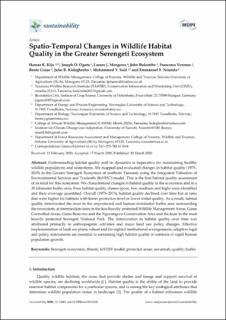| dc.contributor.author | Kija, Hamza | |
| dc.contributor.author | Ogutu, Joseph O | |
| dc.contributor.author | Mangewa, Lazaro J | |
| dc.contributor.author | Bukombe, John | |
| dc.contributor.author | Verones, Francesca | |
| dc.contributor.author | Graae, Bente Jessen | |
| dc.contributor.author | Kideghesho, Jafari Ramadhani | |
| dc.contributor.author | Said, Mohammed Yahya | |
| dc.contributor.author | Nzunda, Emmanuel F. | |
| dc.date.accessioned | 2020-03-23T12:47:51Z | |
| dc.date.available | 2020-03-23T12:47:51Z | |
| dc.date.created | 2020-03-20T20:27:50Z | |
| dc.date.issued | 2020 | |
| dc.identifier.issn | 2071-1050 | |
| dc.identifier.uri | https://hdl.handle.net/11250/2648144 | |
| dc.description.abstract | Understanding habitat quality and its dynamics is imperative for maintaining healthy wildlife populations and ecosystems. We mapped and evaluated changes in habitat quality (1975–2015) in the Greater Serengeti Ecosystem of northern Tanzania using the Integrated Valuation of Environmental Services and Tradeoffs (InVEST) model. This is the first habitat quality assessment of its kind for this ecosystem. We characterized changes in habitat quality in the ecosystem and in a 30 kilometer buffer area. Four habitat quality classes (poor, low, medium and high) were identified and their coverage quantified. Overall (1975–2015), habitat quality declined over time but at rates that were higher for habitats with lower protection level or lower initial quality. As a result, habitat quality deteriorated the most in the unprotected and human-dominated buffer area surrounding the ecosystem, at intermediate rates in the less heavily protected Wildlife Management Areas, Game Controlled Areas, Game Reserves and the Ngorongoro Conservation Area and the least in the most heavily protected Serengeti National Park. The deterioration in habitat quality over time was attributed primarily to anthropogenic activities and major land use policy changes. Effective implementation of land use plans, robust and far-sighted institutional arrangements, adaptive legal and policy instruments are essential to sustaining high habitat quality in contexts of rapid human population growth. | en_US |
| dc.language.iso | eng | en_US |
| dc.publisher | MDPI | en_US |
| dc.rights | Navngivelse 4.0 Internasjonal | * |
| dc.rights.uri | http://creativecommons.org/licenses/by/4.0/deed.no | * |
| dc.title | Spatio-Temporal Changes in Wildlife Habitat Quality in the Greater Serengeti Ecosystem | en_US |
| dc.type | Peer reviewed | en_US |
| dc.type | Journal article | en_US |
| dc.description.version | publishedVersion | en_US |
| dc.source.volume | 12 | en_US |
| dc.source.journal | Sustainability | en_US |
| dc.source.issue | 6 | en_US |
| dc.identifier.doi | 10.3390/su12062440 | |
| dc.identifier.cristin | 1802743 | |
| dc.relation.project | EC/H2020/AfricanBioServices | en_US |
| dc.description.localcode | © 2020 by the authors. Licensee MDPI, Basel, Switzerland. This article is an open access article distributed under the terms and conditions of the Creative Commons Attribution (CC BY) license (http://creativecommons.org/licenses/by/4.0/). | en_US |
| cristin.ispublished | true | |
| cristin.fulltext | original | |
| cristin.qualitycode | 1 | |

